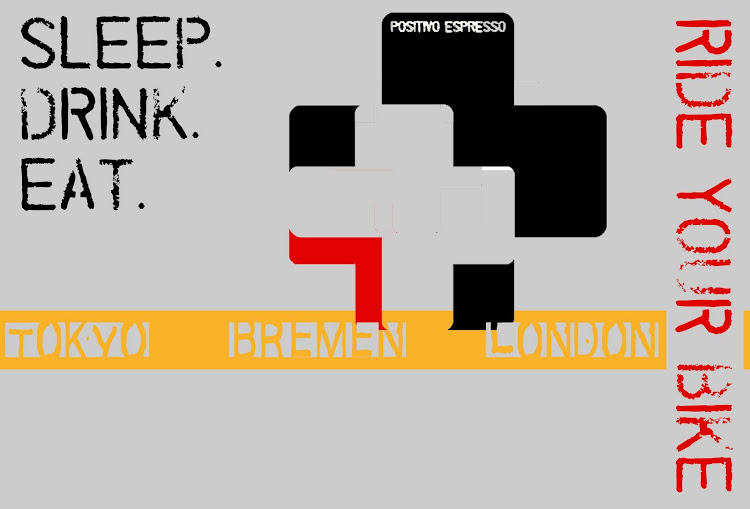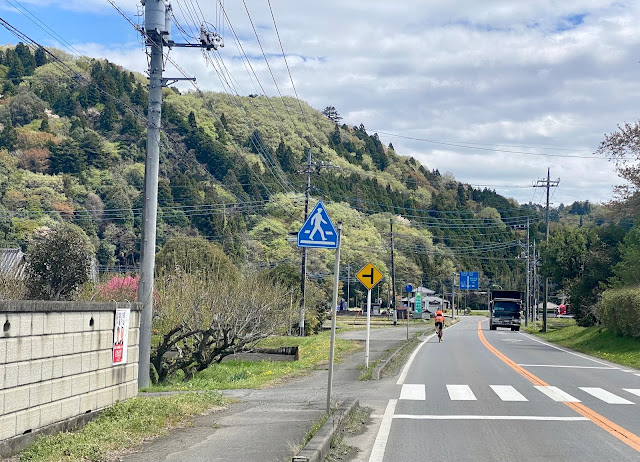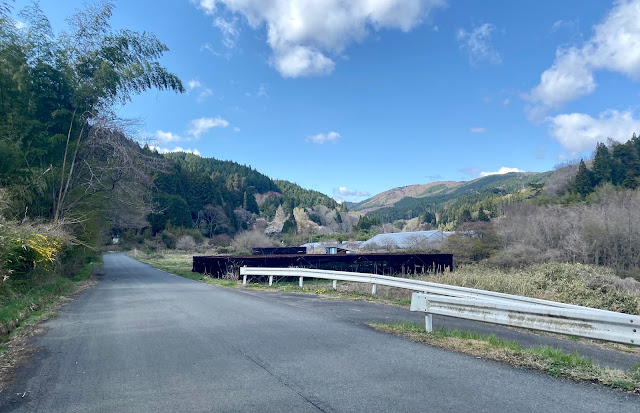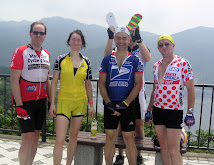 |
| Mt Fuji from the Okuzure Kaigan just SW of Shizuoka-shi |
Jerome and I still needed a 600km brevet to complete our qualifying rides for Cascade1400. There were some interesting 600km rides sponsored by Kanto area Audax groups between now and early June, and we could always repeat the 600km Okitsu Classic (would be my fourth time?!) on May 23, but we wanted to finish qualifying as soon as practical. That way, we can plan our cycling with complete freedom rather than needing to check the box for an Audax event ... well, complete freedom except for work, family, and other commitments.
As we scoured the Audax club websites earlier this year, the best candidate seemed an April 23 Randonneur Tokyo event -- ride to Hamanako just west of Hamamatsu city in Shizuoka, go around the lake (30kms?) and then come back. The ride was relatively flat, many sections were familiar, no truly remote areas without support, and so it seemed to offer a pretty high chance of completion with relatively little ride-specific preparation. On the downside, it involved an all-too-familiar long trip out of/in to Tokyo, as well as coastal areas that are dense in population, and not as high a ratio of spectacular cycling areas/scenery as on my recent 200, 400, and 300 km brevets.
Of course, when we planned our rides, last weekend was supposed to be a "rest" weekend between the 400k and our 600k. Instead, with the postponement of our March 300k, on April 16 we rode our toughest 300k in memory in between, leaving only four days to recover.
The signup for this event was delayed several times, but when we inquired by email, Tsumura-san, the maestro at R-Tokyo, assured us that it would go forward in due course. When the event finally opened for registration, it was as an "N2" format brevet. This Covid-19 countermeasure format means that instead of all gathering in a group, riders have a significant window in which to start their rides, in this case a week ending at 6AM, Saturday April 23. Since a rider need only declare his or her start shortly before heading off (using a Google Form that R-Tokyo set up), it offers maximum freedom to avoid bad weather and match schedules. But the N2 format also means it is easy to do an entire brevet and never meet another rider, especially if you do not start at 6 or 7AM on Saturday morning. That was my experience last Fall when I did an N2 400k event entirely alone.
Jerome and I both decided we would do the ride on Thursday/Friday, April 21-22. That would offer a bit more of a simulation of what we will face during Cascade -- 5 days straight of long rides like these. And, I hoped, I would be "fresh" for work-related duties the following Monday. We each had obligations on Wednesday the 20th, (Jerome's was a family event that would go relatively late at night), and in the end Jerome needed to go to Osaka on Saturday afternoon for work-related meetings and a dinner. I did not feel bad about doing the ride on weekdays, as I have work during Golden Week this year.
I started checking the weather forecast on Monday. Rain was forecast for Thursday afternoon, evening, and into Friday morning in Shizuoka -- the middle half of our ride. And it looked as if the rain would be quite heavy at its peak. The forecast held steady. Well, Jerome could not push back our start by a day, so we would ride in the rain and look at it as training for Cascade, a ride I started and finished in the rain back in 2012, and where this time our first day route goes around the Olympic Peninsula, a rainforest that averages 150 days of rain each year (though June is a relatively low precipitation month).
I wanted to get out of Tokyo before the morning traffic, while Jerome could not get to sleep early, so needed a slightly later start. In the end, I started at 4AM and Jerome at 6AM. That gap meant we would probably end up riding together after he caught me at some point over the next 40 hours. Indeed, he caught up half way through the return leg and we ate lunch then rode the final 25% together.
 |
| 3:40AM, crossing the Tamagawa at Marukobashi |
 |
Fenders on the Sky Blue Parlee -- for a non-sky blue ride!
24x7 dynamo lighting for this trip, so non-matching front and rear wheels still. |
The weather was perfect heading out of town, and the roads were nearly empty for me as I rode the the start (leaving home at 3:15AM), and the first few hours on the course, until about 6AM. The route is a "standard" way for R-Tokyo brevets to head Southwest. First, a long stretch of Nakahara Kaido, then another one on Chogo Kaido, and finally, heading south around the western edge of Hiratsuka to hit the coastline at Oiso. From Oiso to Odawara, we take Route 1. Somehow, I would expect a trip by bicycle from Tokyo to Hamamatsu to involve a lot of riding on Route 1, but this was the only section, and one both familiar to us and very easy to ride. (Another bit between Yui and Okitsu follows a path alongside Route 1, but does not require actually riding on the road).
 |
| Heading west through Kanagawa at first light |
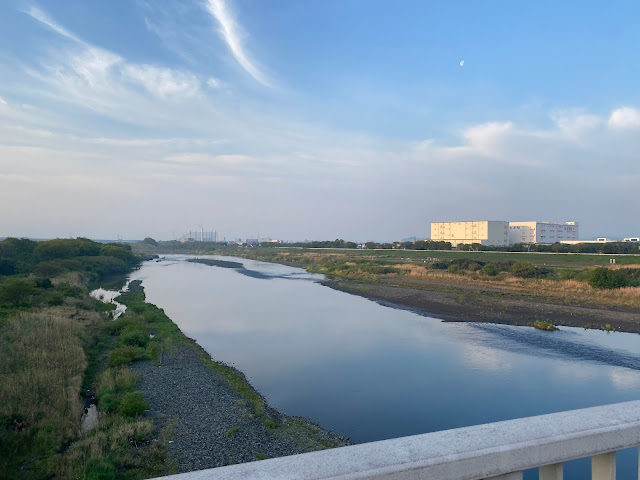 |
| The Sagami River shortly after dawn |
 |
| Finally, some traffic. |
 |
| North of Hiratsuka as the route heads toward the coast |
 |
| Hazy Mt Fuji in the distance |
I stopped at Odawara briefly to get a snack and refill a water bottle from a spigot on the west side of the castle grounds. The scene was lovely at 7AM, only a few people around and flowering azaleas and wisteria.
 |
| At Odawara Castle |
 |
| More Odawara |
It was late enough now so that I experienced full traffic conditions on the next stretch, Route 135 along the coast. Heavy traffic, but at least it is another familiar stretch, and before I knew it I was in Atami. I took another short rest by some azaleas at roadside, ate a half bagel I had brought from home, and started the climb.
 |
| Azaleas and a brief rest in Atami |
Just as I got to a really steep ramp as the road went around a sharp bend, I stood up on the pedals and applied a lot of torque ... and heard a big "ping" snapping sound from my rear wheel. A non-drive side spoke had broken. No worries. I had a spoke wrench and was able to adjust the tension of the two adjacent spokes on each side of the broken one so the rim was "true" again. Indeed, with a deep rim carbon wheel, the rim is stiff enough that I think you could probably ride it with a few broken spokes and not notice much. Then again ... I did see video of Wout van Aert and Christian La Porte's wheels pancaking catastropically last week on Paris-Roubaix, so better safe than sorry! I used to break spokes pretty regularly, even with decent attention to spoke tension. Maybe I am reverting to my former self as a cyclist? That is, indeed, my hope for the year, that I can regain most of the form I had in 2012-2017 or so.
 |
| The cue sheet says to take Route 11 |
Anyway, the climb was painful ... but not as painful as other routes over the mountains above Atami. I think I will use this road again. And the tunnel at just over 400m elevation saves a lot of time and effort as compared to cresting Atami Pass. After exiting the tunnel, there is a long descent to Kannami, at least 7-8 kms. The road is relatively straight and fast. After the first control point (PC) at a convenience store just above Kannami, the route cuts through Mishima/Numazu area. By now I was in heavy morning traffic, in a part of the world that is pretty much car dependent. Patience was required ... as well as some tactical maneuvering onto the sidewalk to pass lines of standing cars.
 |
| Hazy Fuji in the distance as we slog through Numazu area. |
 |
| My conference call stop. |
 |
| Approaching Okitsu Kenko Land -- regular Audax Kanagawa Start/Goal location |
I made it out to the coast and almost to Fuji-shi when I needed to stop 20-30 minutes for a work-related call. I headed into the wooded area and up a stairs to the top of the tsunami wall. The sea and sky were hazy, the boundary of the two indistinct ... reminding me a bit of some of Hiroshi Sugimoto's seascape photos at the Enoura Observatory. Anyway, the call was a bit longer than I hoped, but I did need some rest now 6 1/2 hours from the start, and felt I could spare the time as I was already 130kms into the course and done with the only significant climb of the first half! Jerome reported that he had stopped for breakfast at a Gusto, so he was not yet making up too much time on me.
The route took more familiar territory as I rode through Fuji City, Yui, Okitsu, Shimizu, and then to a PC at the foot of the Miho peninsula. From there it was on down the Ichigo Line (Strawberry Line). This is a very exposed stretch of road along the ocean, so I was relieved not to be facing any significant headwind. Then it was along the south edge/oceanside, of Shizuoka City, through the Okuzure Kaigan area where the road climbs about 100 meters above the crashing waves, then down into Yaezu City.
 |
| Still dry, Okuzure Kaigan |
 |
| Yaezu's harbor area |
The R-Tokyo route turned left along the fishing harbor and hugged the coastline on local roads -- an improvement over the main road I have taken more often between Yaezu and Omaezaki. Everywhere here, as elsewhere, there were azaleas in early bloom. Again I took a short rest -- pulling into a parking lot for a park, attracted by the signage "Discovery Park". Again, I could walk up onto the tsunami levy and this time even enjoy a rest on a bench. 200kms done!
 |
| The coast at Discovery Park Yaezu |
 |
| Randonneur snack |
A few drops of rain started to hit me as I left Discovery Park. Within another 10 minutes, I put on my rain jacket. 15-20 minutes later I put on my rain pants and changed to my Gore tex rain socks. And by the time I got to the Omaezaki checkpoint (km 227), the rain was steady. Jerome had been gaining on me ... but he also had stopped for a work call. I enjoyed a snack of 7-11 pasta with cream sauce, and pushed on.
 |
| Steady rain then dark from here ... so no more Thursday photos. ... except |
I have usually taken National Route 150 along this stretch of coastline -- Omaezaki, then the southern edges of Kikugawa, Kakegawa, Fukuroi, and Hamamatsu. So it was good that the R-Tokyo route is a parallel road just inland. The rain strengthened as I rode west. My lower half was soaked -- the rain pants apparently useless -- but my upper half still somewhat dry and at least it was not too cold. I was glad to have fenders both front and rear wheel. I stopped once at a pedestrian underpass that sheltered me a bit from the rain, where I could eat an onigiri and call Jerome to check in.
The route travels along the coast south of Hamamatsu, and I had managed to hit Thursday afternoon rush hour traffic as cars zoomed by me along one particularly crowded stretch. There were lots of signs for central Hamamatsu, but no city. The most obvious landmarks were some hotels -- "Dior Seven", and "Bel Grave". They were obviously love hotels, lights lighting up the evening sky, beckoning couples. There were also some golf driving ranges, huge nets along each side, but they lacked signs or features to distinguish one from another to the untrained eye. I think people around here probably give directions like "take a right turn just before Dior Seven, proceed to the second traffic light after Bel Grave, then another right turn." Anyway, Jerome's son now works for the real Dior, so he snapped a photo of the hotel just in case the real Dior thinks it is worthy of a trademark infringement lawsuit.
Finally, I arrived at the 281km 7-11 PC. It was now raining cats and dogs. Even the area just along the front of the store, under the overhang, was too wet to sit. Jerome was still way behind me. I told him I would push on to the hotel, near km 320.
And thus began what should have been the highlight of the ride -- a chance to go around Hamanako (Lake Hamana) by bicycle. But by now it was dark, and the rain was hard. And the wind from the NNW was straight in my face. The next 20 kms seemed to take forever, pushing into the wind and rain. After a few kms there was very little traffic, at least.
At last I reached the northern tip of the lake and the route turned toward the west then southwest, with a wind from the rear right. I felt like a sailor on a boat that had come about and swung toward a broad reach. Finally progress was easy. But the next PC was not a convenience store, it was an unmanned and nearly unmarked train station. As I cycled up a slope, I finally saw a hut that might be a station on the left side of the road. I dismounted and walked over. The platform showed a mark "Sunza" as the name. I pulled out my brevet card/sheet and saw that Sunza was not the PC. Back on the bike and a few kms further along when the highway again neared the train tracks, I finally pulled off again at the correct station. The station waiting room was empty, but at least the door was open so I could go in to take out my card and get my smartphone camera ready for a "proof of passage photo" as instructed.
 |
| late Thursday ... proof of passage photo |
The route soon turned off the main highway and followed a small road along the lake for some kilometers. There was dark vast water on the left, water on the road, and water falling from the sky. I could imagine that this was a nice place to have a vacation home, or to visit and stay in one of a few hotels or resorts I passed. I will need to go back when it is light out and not raining.
After another 30-45 minutes on back on the bike, in the wet, I stopped at another convenience store. I asked if the hotel, Route Inn, was ahead. The clerk confirmed that yes, it was not far, and was visible from the road. I got some food to eat once I got in my hotel room -- it would be after 9PM by my arrival, so I could not count on a restaurant being open, nor would I want to "waste" time I could use for sleep hunting for food. 15 minutes later I arrived at the hotel. I apologized for being soaking wet as I trampled through the lobby. The man and woman at the front desk ... immediately handed me a bath towel so I could wipe down. Ahh. I asked if there was a place I could keep my bicycle dry and secure for the night. They said "if it is a road bike, you can take it to your room". I was a bit surprised. "It is really wet, and a bit dirty". They said it was just fine. Wow. Very different from the reaction one would have gotten at a Route Inn or similar ten years ago! I guess the local cycling promotion activities around Japan (Hamanako had lots of signs for a bike route around the lake, similar to Ibaraki, and Izu, Shimanami Kaido, and other places) has had an impact on the hotels.
Jerome was still 90 minutes behind. After a hot bath and some food, as I was getting ready to sleep, he called me reporting trouble finding the train station PC. His GPS unit had gone haywire so he was navigating using ridewithgps on his smartphone screen. I calmed him down and got him to switch the phone to Google Maps, where he could find the exact location of the station, not far away. I lay down in bed and was immediately asleep. It was already 1030PM. I had planned to be on the road at 130, but decided to push it back to 2AM (with a generous 30 minutes to get dressed and out the door) as the rain was not supposed to stop until 2-3AM.
I woke after an hour, then again was out immediately. My alarm woke me at 130AM. The rain seemed to have let up, but not entirely. There was a text message from Jerome -- "call me when you wake up" -- that continued to say he would probably not join but leave later. I called and woke him. He had just gone to sleep ... said something about getting a bit lost, about drinking a large beer with his food after arriving at the hotel and said he would sleep more and follow later.
 |
| Very very early Friday, somewhere out there is Hamamatsu, or maybe Iwata |
I stowed my rain pants, dressed in my clothes that had been hanging but were still very wet, and headed out. The roads were quiet, and the next PC was about 12kms away, at km 331. It turned out to be the same 7-11 as the 281km PC. By now the rain had stopped entirely. In a few hours, with the morning sun, the roads would be dry! And it was warm enough so the weather was no longer a factor. Before long, I saw the Bel Grave and the Dior Seven, still lit up even in the wee hours.
I called Jerome at 330AM. He answered immediately and said he was preparing to leave the hotel. So again a 90 minute head start. The stretch to Omaezaki was flat and I could roll at a decent speed without much effort. I reached the Omaezaki PC just after 5AM. A bit of a tailwind heading NE, and another rest at Discovery Park around 645AM -- this time Mt Fuji visible in the distance! There were lots of Mt. Fuji views today, almost as many as there were azalea.
 |
| Descent after Omaezaki PC |
 |
| On the road to Yaezu |
 |
| More Fuji |
 |
| More azaleas |
 |
| Back at Discovery Park |
I passed the Okuzure Kaigan again, just before 8AM, and the Shizuoka checkpoint around 830AM. The Ichigo Line wind was blowing and had shifted, but at least it was not a direct, full-on headwind.
 |
| Dramatic, crashing surf all the way from here to Ichigo Line |
Jerome was catching up, and we agreed to try and get an early lunch together in Fuji-shi or Numazu. There was a Gusto family restaurant (our standby) directly on the route. He was flying now, and was less than 30 minutes behind me, and closed most of that gap by the time I crossed the Fujikawa. I arrived at the restaurant only 5-10 minutes ahead of him, and we rode the last 150kms together.
I was a bit worried about the time limit for this event. By stopping at the hotel from 9PM to 2AM, I had lost all my "savings" and placed myself in a bit of a time deficit. The R-Tokyo organizers had provided us maximum flexibility by not imposing interim time limits at the PCs. I had 200kms to go with 13 hours left -- plenty of time. But coming out of Gusto after 11AM, we had under 9 hours for nearly 150 kms, including the Atami climb.
Passing through Numazu, we saw ... at least 4 riders headed the outbound leg, including Tsumura-san himself. They had used common sense and started Friday morning, after the rain, and were enjoying the lovely, even warm day! (Update: I heard later from Tsumura-san that they faced constant headwinds in the afternoon ... that "defeated" him. So we actually may have made the smart move by riding into the impending rainstorm?)
 |
| Azaleas everywhere! |
 |
| Back through Numazu |
We were both hot by the time we reached the Kannami PC, which was a different convenience store down nearer to the town. At least we had caught up with the "time limit" from our lunch break and were again well "ahead" of the notional cut-off time as we entered the PC, so a 15km per hour pace would mean we finished in time.
But we dawdled at this PC. And when we were about to leave, I suggested to Jerome that I could save a lot of weight and heat if I put my rain gear and cold weather gear plus some other unneeded items in my rucksack and sent it on by Yamato. We went in the convenience store. After about 5 minutes of attempted discussion, it was clear that Lawson only handles Japan Post, and their only relevant service "Yu Pack" would not take a bare rucksack.
We finally left and headed to start the climb. Maybe if we were lucky we would find a place to ship my rucksack (and Jerome's -- he had adopted the idea). About 150 meters ahead ... there was a 7-11. But it was still a challenge to ship the items. The arubaito working there had never done it before, it seemed. What were the dimensions of a shapeless rucksack? Would I buy a plastic bag to put it in so the straps were not loose? I wanted to just throw some money at him with the address label and run out the door. I said "we are in a big hurry, so I am happy to pay a bit extra and don't need it measured exactly." He got the message, charged me JPY 1750, and handed me the receipt. Jerome was still trying to have the same discussion with the other clerk, and I said I would ride ahead.... I knew he would catch me on the long climb ahead. We had burned in total at least 20 minutes trying to send our bags, after the 20 minute rest stop that preceded it. Now there was not a moment to lose!
Actually, I made it up the climb I thought in pretty good shape. It was shorter than I had thought, and not nearly as steep as the East side, of course. Jerome caught up with me only after I had gone through the 2km tunnel at the top and was starting the descent.
My rear brake cable had been acting up a bit and seemed stuck somewhere at times ... and early on the descent it snapped entirely. Oh well, 75-80% of braking power is the front brake anyway. But this was a steep winding Atami descent, and I would be sitting on the lone brake, heating up my front rim. Now was NOT the time for an accident, or a heat-induced burst tire tube. (That also has happened to me before a few times when riding aluminum rim clinchers ... it happened back when I was breaking lots of spokes.) So I took it slow going down the hill, and even stopped once for a rest to let the rim cool. ... I also noticed that my front brake pads were getting ... very thin. If needed, I could swap the now-useless rear ones into the front, but I hoped the current pads would make it through all the crazy hills on Nakahara Kaido.
We reached the Tokyo metropolitan area just as Friday evening rush hour was in full swing. At times we had to ride past lines of standing cars and trucks. Lots of trucks. Anyway, we made it safely to the goal at 730PM with about 30 minutes to spare. At least it was enough time so that, once past Odawara, I knew there was enough time without too much worry. Jerome, starting 2 hours later, had plenty of time.
 |
| We celebrated with steak dinner and beer at the nearest place to the finish line. Then home to sleep. |
In total, I rode 633kms. Not bad. Then again, for a course like this, I would have expected to ride it in under 36 hours, not 39 1/2 hours. Sure, this ride was only four days after the monster 300k, and neither of us had enough sleep the night before. We rode in rain (and full rain gear) for six hours (Jerome for more). And the hotel stop was 5 hours, the work call 30 minutes, the Gusto lunch at least 45, the Kannami dawdling another 20+ longer than expected, and the two mechanicals, one of which required extra caution riding the last 100kms. But there is relatively minimal climbing on this route (for Japan -- "only" 3660m elevation gain total), no gravel, no serious headwinds, no searing heat, and so I was expecting to do it several hours faster. There is still more work to be done before Cascade. But at least I am done with the qualifiers! And done with my first 600k since 2019! And my body experienced an intense two-day effort while still recovering from the last brevet, or maybe the last two brevets. So I think I am on the way.
The R-Tokyo route can be found here on RidewithGPS.



